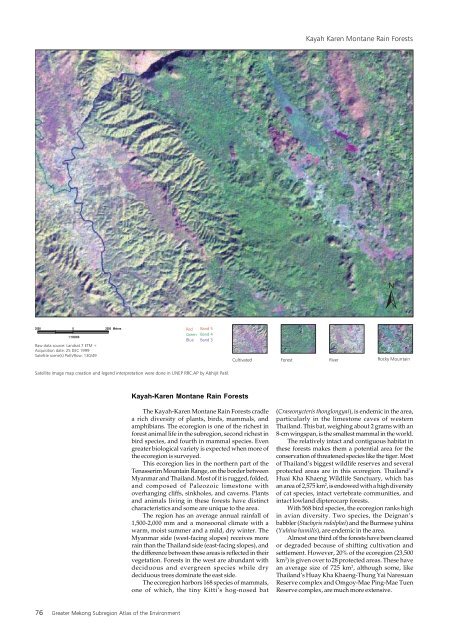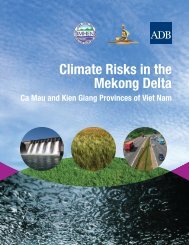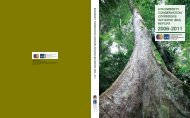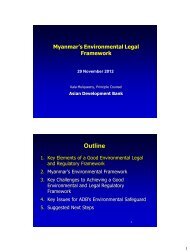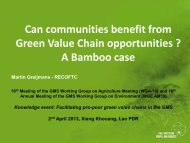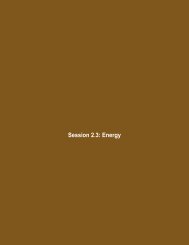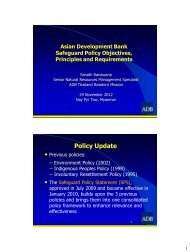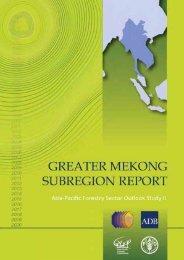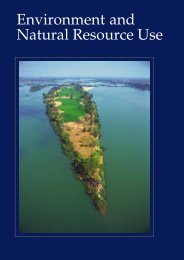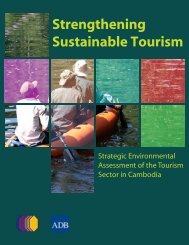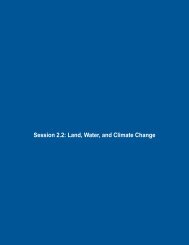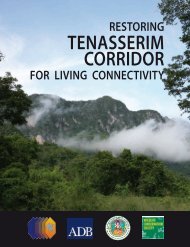Kayah-Karen Montane Rain ForestsThe Kayah-Karen Montane Rain Forests cradlea rich diversity of plants, birds, mammals, andamphibians. The ecoregion is one of the richest inforest animal life in the subregion, second richest inbird species, and fourth in mammal species. Evengreater biological variety is expected when more ofthe ecoregion is surveyed.This ecoregion lies in the northern part of theTenasserim Mountain Range, on the border betweenMyanmar and Thailand. Most of it is rugged, folded,and composed of Paleozoic limestone withoverhanging cliffs, sinkholes, and caverns. Plantsand animals living in these forests have distinctcharacteristics and some are unique to the area.The region has an average annual rainfall of1,500-2,000 mm and a monsoonal climate with awarm, moist summer and a mild, dry winter. TheMyanmar side (west-facing slopes) receives morerain than the Thailand side (east-facing slopes), andthe difference between these areas is reflected in theirvegetation. Forests in the west are abundant withdeciduous and evergreen species while drydeciduous trees dominate the east side.The ecoregion harbors 168 species of mammals,one of which, the tiny Kitti’s hog-nosed bat(Craseonycteris thonglongyai), is endemic in the area,particularly in the limestone caves of westernThailand. This bat, weighing about 2 grams with an8-cm wingspan, is the smallest mammal in the world.The relatively intact and contiguous habitat inthese forests makes them a potential area for theconservation of threatened species like the tiger. Mostof Thailand’s biggest wildlife reserves and severalprotected areas are in this ecoregion. Thailand’sHuai Kha Khaeng Wildlife Sanctuary, which hasan area of 2,575 km 2 , is endowed with a high diversityof cat species, intact vertebrate communities, andintact lowland dipterocarp forests.With 568 bird species, the ecoregion ranks highin avian diversity. Two species, the Deignan’sbabbler (Stachyris rodolphei) and the Burmese yuhina(Yuhina humilis), are endemic in the area.Almost one third of the forests have been clearedor degraded because of shifting cultivation andsettlement. However, 20% of the ecoregion (23,500km 2 ) is given over to 28 protected areas. These havean average size of 725 km 2 , although some, likeThailand’s Huay Kha Khaeng-Thung Yai NaresuanReserve complex and Omgoy-Mae Ping-Mae TuenReserve complex, are much more extensive.76 Greater Mekong Subregion Atlas of the Environment
FaunaRecent discoveries of new species (such as thesaola, a forest dwelling ox, found in the Annamitesin 1993) and the dedicated search for the elusivekouprey have captured the imagination ofconservationists worldwide and heightened globalawareness of the need to conserve the biodiversityof the subregion. Biological surveys continue to turnup new discoveries, emphasizing the region’s highconcentration of unique plants and animals. Thesesurveys also highlight the fact that the subregion ishome to some of the world’s most threatened species.While a few have become extinct (such asSchromburk’s deer, the pink-headed duck, and thewhite-eyed river-martin), most species are stillrelatively widespread in the subregion. However,wildlife populations are coming under increasingpressure from growing human populations,infrastructure development, and extraction forinternational markets. Many species of largemammals are close to extinction in several countries.These include the tiger, banteng, wild water buffalo,Eld’s deer, and Javan and Sumatran rhinoceroses.Other threatened groups include large water birds(such as cranes, storks, ibises, and pelicans),pheasants, large foragers (hornbills, imperialpigeons), freshwater turtles, and large migratoryfish.Asian Elephant (Elephas maximus)The Asian elephant is the largest land mammalspecies in the subregion, growing to about 6.5 mlong and 3 m high. Adult males weigh about 5,000kilograms (kg); females, 3,000 kg. They live for about40 years. While an estimated 30,000–50,000 Asianelephants are believed to survive, the species isnearing extinction in the wild in many areas. Theanimals need space, preferring tropical grassy plainand rainforest habitats. Deforestation and humanencroachment have led to widespread habitat loss.Calves of Asian elephants are also kidnapped foruse as beasts of burden, especially in the loggingtrade.Banteng (Bos javanicus)Considered one of the most beautiful kinds ofwild cattle, the banteng is an endangered speciesfound mostly in Myanmar and Thailand. It lookssimilar to an ox, only larger. It has white “stockings”on its legs, a white rump, a white muzzle, and whitespots above the eyes. The banteng prefers to live inopen, dry, deciduous forest, although in Borneo,some dwell within evergreen forests. This hugeanimal is very timid and retiring and feeds at nightin areas where humans encroach. Bantengs usuallyroam in herds of one bull and several cows andcalves. Some bulls stay alone and join the herds onlyduring the breeding season. Bantengs are known tobe grazers but they also consume available leavesand fruits. They live up to 20–25 years.A rapid decline in their population wasobserved in the early 1990s. According to IUCN(2000), they number no more than 5,000. Huntingand loss of habitat endanger their existence.Interbreeding with domestic and other cattlethreatens the genetic integrity of the banteng.Douc Langur (Pygathrix)Douc langurs of the genus Pygathrix are nativeto Southeast Asia. Up until only a few years ago,two distinct taxa were recognized—the red-shankedand the black-shanked douc langur. BetweenAugust 1995 and January 1998, however, six malespecimens of the new and distinctive Pygathrixcinereus were found, some confiscated by Vietnamesewildlife authorities and the others donated by privateindividuals and placed in Cuc Phuong NationalPark. The animals had evidently originated in thesoutheastern part of Viet Nam’s Central Highlands,Asian elephant (upper); douc langur(lower left); bantengs (lower right)Environment and Natural Resource Use 77


